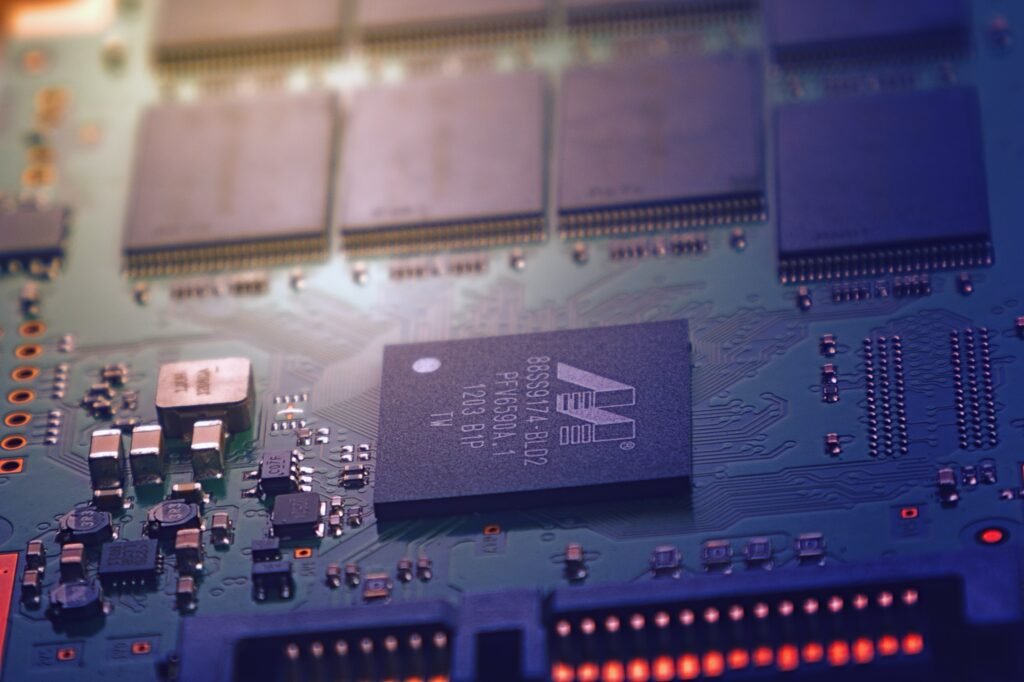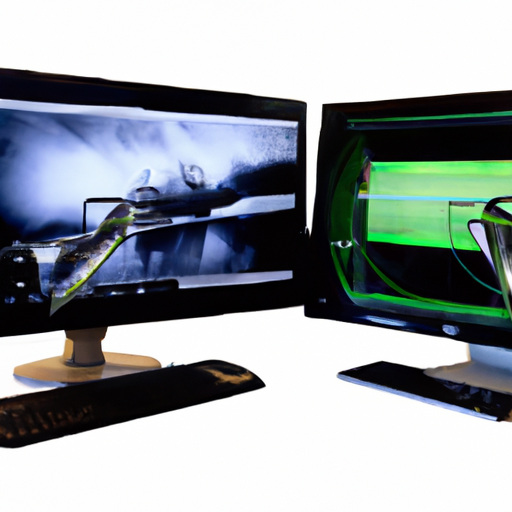In the ever-evolving world of technology, the question of how wireless video monitors compare to their wired counterparts has become increasingly relevant. With our ever-growing need for convenience and mobility, wireless options have emerged as a popular choice for monitoring video feeds. But how does their performance stack up against their wired counterparts? In this article, we will explore the pros and cons of both wireless and wired video monitors, providing you with a comprehensive understanding of which option may be best suited to your needs. So, let’s embark on this journey and unravel the mysteries of wireless versus wired video monitors together!
This image is property of images.unsplash.com.
Resolution
When it comes to resolution, both wireless and wired monitors offer similar picture quality. Whether you choose a wireless or wired monitor, you can expect sharp and clear visuals. The resolution of a monitor refers to the number of pixels it can display. Higher resolution monitors will provide more detail and clarity in the images and videos. Whether you are watching movies, playing games, or working on graphic design projects, both wireless and wired monitors will offer a satisfying viewing experience.
Wireless monitor resolution
Wireless monitors are designed to provide high-definition visuals without the need for cables. These monitors use wireless technology to transmit the video signal from your device to the monitor. Most wireless monitors today offer a resolution of 1080p (Full HD) or even higher. Some advanced wireless monitors even support 4K resolution, delivering stunning picture quality. So, if you’re looking for a wireless monitor, rest assured that you won’t have to compromise on resolution.
Wired monitor resolution
On the other hand, wired monitors are also capable of delivering impressive resolutions. With a wired connection, you can easily achieve higher resolutions, such as 4K or even 8K. Wired monitors offer a stable and reliable connection, which can be advantageous when it comes to high-resolution content. So, if you’re a professional video editor or someone who demands the highest level of detail in their visuals, a wired monitor might be the better choice for you.
Latency
Latency is an essential factor to consider when choosing a monitor, especially if you’re a gamer or work with applications that require real-time responsiveness. Latency refers to the delay between the time a signal is sent to the monitor and the time it takes for the monitor to display that signal. Both wireless and wired monitors have different levels of latency, so let’s take a closer look at each.
Wireless monitor latency
Wireless monitors, by their nature, require some degree of data transfer which can introduce latency. However, advancements in wireless technology have significantly reduced latency in modern wireless monitors. While wireless monitors can provide a smooth experience for everyday use, they might not be ideal for competitive gaming or applications that demand extremely low latency. If you’re a casual gamer or use your monitor for general purposes, the latency of a wireless monitor should not pose any noticeable issues.
Wired monitor latency
Wired monitors, on the other hand, have the advantage of a direct and dedicated connection, resulting in very low latency. The wired connection ensures quick transmission of signals between your device and the monitor, making it an excellent choice for gamers and professionals who require instant response times. If you’re looking to minimize latency and experience the best possible responsiveness, a wired monitor is the way to go.
Installation
The installation process of a monitor can play a significant role in its usability. Let’s explore how wireless and wired monitors differ in terms of installation.
Wireless monitor installation
One of the key advantages of wireless monitors is their ease of installation. Unlike wired monitors that require cables to be connected, wireless monitors can be set up with minimal effort. Simply connect the wireless transmitter to your computer or other devices, and the monitor will communicate wirelessly. This eliminates the need for cable management and provides a cleaner and more organized workspace. The wireless nature of these monitors allows for more flexibility in terms of monitor placement, as you are not restricted by cable length.
Wired monitor installation
While wired monitors may seem slightly more complicated to install due to the need for cables, they offer their own benefits. Setting up a wired monitor typically involves connecting the monitor to your computer or another device using a cable, such as HDMI or DisplayPort. Although this may require some cable management, a wired connection ensures a reliable and stable connection. If you prefer a more traditional setup or need a monitor that can handle high-bandwidth tasks, a wired monitor might be the better option for you.
Flexibility
Flexibility is an important factor to consider when choosing a monitor, as it determines how easily you can adjust and position the monitor according to your needs. Let’s compare the flexibility of wireless and wired monitors.
Wireless monitor flexibility
Wireless monitors offer excellent flexibility due to their lack of cables. With a wireless monitor, you have the freedom to position the monitor wherever you desire without worrying about cable length limitations. This flexibility can be particularly beneficial in situations where you frequently need to move or reposition your monitor. Whether you need to switch between different workstations or simply want the freedom to rearrange your setup, a wireless monitor provides the flexibility to do so. This makes wireless monitors an excellent choice for those who value convenience and adaptability.
Wired monitor flexibility
While wired monitors may seem less flexible compared to their wireless counterparts, they still offer a reasonable level of flexibility. Although you need to consider cable length restrictions, once the monitor is set up, it remains in place without any signal loss or interruption. Additionally, modern wired monitors often come with adjustable stands or mounting options, allowing you to change the height and orientation as needed. While wired monitors may require more thought and planning in terms of cable management, they can still provide a comfortable viewing experience with adjustable positioning options.

This image is property of images.unsplash.com.
Mobility
If portability is a priority for your monitor needs, it’s crucial to consider mobility. Let’s explore how wireless and wired monitors compare in terms of mobility.
Wireless monitor mobility
Wireless monitors excel in terms of mobility. The absence of cables allows you to easily move or transport your monitor from one location to another without the hassle of disconnecting and reconnecting cables. This is particularly advantageous if you frequently travel or need to work in different environments. Wireless monitors are compact and lightweight, making them convenient to carry around. Whether you’re a freelancer working on-the-go or someone who often attends presentations or conferences, a wireless monitor offers the utmost mobility.
Wired monitor mobility
Wired monitors, due to their reliance on cables, are less mobile compared to their wireless counterparts. Once set up, wired monitors are best suited for stationary use. While you can certainly move a wired monitor if needed, it requires disconnecting and reconnecting cables, which can be time-consuming and cumbersome. If mobility is a key requirement for your monitor usage, a wired monitor may not be ideal, especially if you frequently need to transport or reposition your monitor.
Interference
Interference can have a significant impact on the performance and reliability of a monitor. Let’s compare how wireless and wired monitors handle interference.
Wireless monitor interference
Wireless monitors are susceptible to interference from other devices that use similar frequencies, such as Wi-Fi routers or Bluetooth devices. This interference can cause disruptions in the video signal, resulting in degraded image quality or even complete signal loss. However, modern wireless monitors are designed to mitigate interference by utilizing advanced wireless technologies and selecting less crowded frequency bands. To ensure optimal performance and minimize interference, it’s crucial to position your wireless monitor away from other wireless devices and obstacles that can block the signal.
Wired monitor interference
Wired monitors, being connected directly to your device, are not prone to interference issues. The wired connection provides a stable and reliable signal, unaffected by external factors such as nearby devices or physical obstacles. With a wired monitor, you can enjoy a consistent video signal without worrying about interference. Whether you’re working on critical projects, gaming competitively, or simply want a reliable display, a wired monitor guarantees a stable and uninterrupted viewing experience.

This image is property of images.unsplash.com.
Cost
The cost of a monitor is an important consideration for many buyers. Let’s compare the costs of wireless and wired monitors.
Wireless monitor cost
Wireless monitors tend to be slightly more expensive compared to wired monitors. The additional cost can be attributed to the wireless technology and components required for wireless transmission. However, the price difference between wireless and wired monitors has decreased over the years, and there are now affordable options available in the market. If you value the convenience and flexibility of a wireless monitor and are willing to invest a bit more, the cost difference might be worth it for you.
Wired monitor cost
Wired monitors, as the more traditional option, generally come at a lower price point compared to wireless monitors. The absence of wireless technology and the simplicity of a wired connection contribute to lower manufacturing costs, which are often passed on to the consumers. If you have budget constraints, a wired monitor may be the more cost-effective choice for you. Despite the lower price tag, wired monitors still offer excellent picture quality and performance.
Power Consumption
Power consumption is an important consideration for those who are conscious of their energy usage and want to minimize their environmental impact. Let’s compare the power consumption of wireless and wired monitors.
Wireless monitor power consumption
Wireless monitors typically rely on internal batteries or external power sources to operate. The power consumption of a wireless monitor varies depending on factors such as screen size, display technology, and usage patterns. However, due to the wireless transmission technology and components, wireless monitors generally consume more power compared to wired monitors. If you prioritize energy efficiency and want to reduce power consumption, a wired monitor would be the more environmentally friendly option.
Wired monitor power consumption
Wired monitors are designed to be connected to a power source, drawing power directly from the outlet. The power consumption of a wired monitor can vary depending on factors such as screen size, display technology, and brightness settings. However, since wired monitors do not rely on additional wireless components, they tend to consume less power compared to wireless monitors. If energy efficiency is a concern for you, a wired monitor is the more environmentally conscious choice.
Signal Range
The signal range of a monitor determines how far away you can be from the display while still maintaining a clear and stable connection. Let’s compare the signal range of wireless and wired monitors.
Wireless monitor signal range
Wireless monitors typically have a limited signal range, which can vary depending on the specific model. The signal range is influenced by factors such as the strength of the wireless transmitter and potential obstacles between the transmitter and the monitor. In general, you can expect a signal range of up to several meters for most wireless monitors. Keep in mind that the signal strength may weaken as you move farther away from the transmitter. If you require a monitor that can be placed at a considerable distance from your device, a wired monitor might be a more suitable choice.
Wired monitor signal range
Unlike their wireless counterparts, wired monitors do not have a signal range limitation. As long as your device is physically connected to the monitor, you can enjoy a clear and stable signal regardless of the distance between them. This is particularly beneficial in scenarios where you need to place your device far away from the display, such as when using a desktop computer with a tower unit located under the desk. With a wired monitor, you can position your device wherever is most convenient for your workspace setup.
Network Security
For those concerned about the security of their monitor connections, it’s important to consider the network security aspects of wireless and wired monitors.
Wireless monitor network security
Wireless monitors transmit their signals wirelessly, making them potentially vulnerable to unauthorized access or interference. However, modern wireless monitors implement various security protocols, such as encryption, to ensure secure and tamper-proof transmissions. It’s crucial to choose a wireless monitor that supports the latest security standards and has the necessary security features enabled. By taking proper precautions, such as using strong passwords and keeping your wireless network secure, you can minimize the risk of unauthorized access to your wireless monitor.
Wired monitor network security
Wired monitors, as they do not rely on wireless transmissions, are inherently more secure compared to wireless monitors. Since the signal is transmitted through a physical cable, the chances of unauthorized access or interference are significantly reduced. This makes wired monitors a preferred choice for those who prioritize network security. However, it’s still important to follow best practices in securing your overall network, especially if the monitor is connected to a computer or device that accesses the internet.
In conclusion, wireless and wired monitors each have their own strengths and weaknesses. When choosing between the two, consider factors such as resolution, latency, installation, flexibility, mobility, interference, cost, power consumption, signal range, and network security. Wireless monitors offer convenience, flexibility, and mobility, while wired monitors provide higher reliability, lower latency, and better security. Ultimately, the decision will depend on your specific needs, preferences, and budget. Whether you choose a wireless or wired monitor, both can offer excellent visual experiences, so choose the one that best suits your requirements.

Meet Penny Sterling, the editor behind the captivating content of our blog, “Wireless Video Monitor.” With a background in electrical engineering and a deep passion for technology, Penny has become a leading authority in the world of wireless video monitors. Her ability to distill complex concepts into accessible articles has made her a trusted guide for both tech enthusiasts and newcomers to the field. Penny’s unwavering commitment to research and staying up-to-date ensures that “Wireless Video Monitor” remains an authoritative source for reliable information. Get ready to embark on a journey of wireless video monitor exploration with Penny Sterling as your knowledgeable and dedicated mentor.


